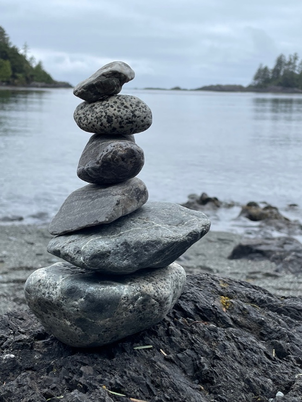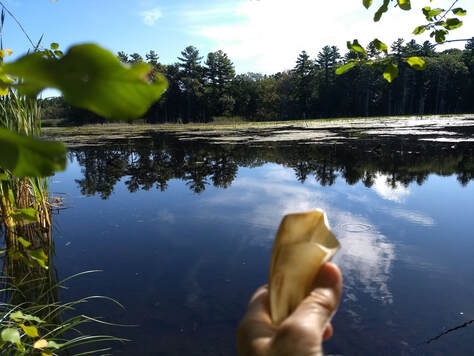|
by Deb Nam-Krane In 2022, after a decade of worsening symptoms that included erratic energy as well as digestive issues – and plenty of gaslighting – I was diagnosed with colon cancer. It was serious enough that even after every visible trace had been removed I needed to undergo chemotherapy treatments. Just as I should have gotten the attention I needed earlier, climate scientists should have been heeded when we were at "crisis", not "emergency". But once we identify the causes and agree on the treatments, improvements can be seen immediately. Just as we could excise malignant cells from my body, we can stop the activities that are causing so much damage to our atmosphere, and we could do it immediately. There will still be leftover damage, just as cancer can leave scars or metastasis even after it's been removed. However, as someone who focuses on agricultural solutions, I continue to be amazed by how quickly many of those scars can be healed once we start to, literally, put the carbon back where it belongs. Carbon drawn down from the atmosphere enriches our soils and strengthens the microbial networks which make our plants – and trees, and everything that lives off of them – stronger in turn. Just as millions like me can recover from a cancer that could have killed us a decade ago, the Earth can recover from centuries of pollution and hubris – and like me and other survivors, it can come back stronger than ever. I have experienced my t'shuvah, my return to myself, and I still see opportunities for the Earth – and everyone on it – to experience the same. Deb Nam-Krane is a mother, wife, writer, environmentalist, and gardener in Boston.
0 Comments
by Steven J Rubenstein During the late spring, my wife and I joined her son and daughter-in-law on a trip to Vancouver Island off the western coast of Canada, bordering Seattle, Washington. So many things reminded me of previous events in my journeys that are so life-affirming. First and foremost were the majestic mountains of the Canadian Rockies, holding on to the last vestiges of snow in late May at their peaks. They reminded me of my seven years in Denver and my view of the American Rockies on my way to work as I prayed the words: “Mah rabu ma’asekha, Adonai... How wonderful are your works, Adonai; You fashioned them all...” Contrast that with the trees climbing up the slope of the mountain creating a skirt of green ~ with patches of brown where forestation has begun eroding the landscape. My heart sank at the sight, as if I were looking at an open wound upon the earth, wondering what type of band-aid might be effective in covering the pain at looking upon the baroness. How can I offer teshuvah for the damage that has been done. A short walk into the old-growth forests, introduced me to some trees dating to the time when Marco Polo began his explorations in the 1200s. Looking up at the tall cedars towering over the canopy of trees made me dizzy. Rivers of melting snow provided us with another reason to stop and admire the torrents as it forced its way through a passage of rocks. I tried to compare them to my experience at Niagara Falls and all of its grandeur. My heart pounded with the fierceness of the water while I stood on a ledge with my camera, pretending I was not in the most vulnerable position of falling. I took many photographs of the water spraying from the impact of hitting the rocks below me in the late afternoon sun. However, none of those photographs compare to the beauty in the stillness of some pools of water left behind on the rock face, where I captured the reflections of the trees in the “still waters.” Above the water on a telephone pole by the side of the road was a sign that read, “Live free!” Challenge accepted! I felt cleansed by the rushing water! The waters of the Pacific Ocean were no less wild, or perhaps even more so when I was caught flat-footed in the sand by a rogue wave. I thought that I could outrun the washoff from the wave hitting the shore as it slid towards me. I was wrong and I paid the price of wearing wet shoes for the remainder of the day. What amazed me were the designs in the sand left by the receding waves. There was a message in their shapes. Clearly, the messages were different from the ones at the beach near my parents’ home on Cape Cod. Nature has a way to show its tears in the sand. I share with you the carbon footprint that I left in two places where I stopped to ponder God’s creation. Just as our former ancestor, Jacob, took the stones from the place where he had stopped overnight, and declared with awe and wonder that God was in this place, how could he not know; I, too, gathered some stones for others to know the sacredness of what it meant to be in such a God-place ~ “Mah tovu ohalekha, Ya’a-ko; mishkinotekha, Yisrael. I left a marker for others to stop and contemplate the holiness of this place and see for themselves through the eyes of a photographer how lines and shapes work together, with color and substance to create a greater picture that can delight all of the senses. May my monument be a testimony to God for forgiveness. Steven J Rubenstein is the Director of Spiritual Care at Jewish Senior Life, a continuum care facility in Rochester, New York.
by Rabbi Katy Z. Allen We are rolling around to Elul now on the Jewish calendar. It feels too soon, and yet, it also feels right on time. Too soon, because Elul always comes too soon. I'm never really ready. And right on time, because it's impossible to be ready. The clock ticks, the calendar days fly by, and IT arrives, whatever IT may be. A wedding, a birth, death, the start of a new school year, Shabbat, a difficult conversation – whatever it is we are awaiting, it always comes too soon – or sometimes not soon enough – and it always comes on time. And so, we pull out the shofar to begin blowing -- or hearing -- it every morning, a reminder to wake up and get ready for the Yamim Noraim, the Days of Awe, and the super-intensity of trying to let go of our defects and come closer to the Mystery. We acknowledge that summer will again draw to a close, always too soon. We watch the sun set earlier each day and light our Shabbat candles earlier each week, but always, always, on time, on their time, on the time of the Universe and of G!d.
Welcome to this year's Earth Etudes for Elul, which will start Sunday evening, written by environmentalists, poets, rabbis, and others, bits of reflection and wisdom on Earth and teshuvah for your journey through this month. Enjoy and b'hatzlachah - good luck with this year's efforts for personal change! If you would like to subscribe to the blog, click here or use the link at the upper right. Elul tov – may you have a good and wondrous Elul. Rabbi Katy Allen is the founder and rabbi of Ma'yan Tikvah - A Wellspring of Hope, which holds services outdoors all year long, and the founder and President pro-tem of the Jewish Climate Action Network-MA. She is a board certified chaplain and a former hospital and hospice chaplain. She received her ordination from the Academy for Jewish Religion in Yonkers, NY in 2005 and lives in Wayland, MA with her spouse, Gabi Mezger, who leads the.singing at Ma'yan Tikvah. |



 RSS Feed
RSS Feed